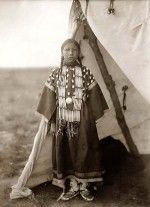Are You Willing to Become Part of the Solution?

As cold weather nears and we bundle up in our warm winter coats, hats and boots, it is hard to imagine that at the same time, half way across the country in South Dakota, thousands of children, members of the Oglala Lakota Sioux tribe, are running through feet of snow from their mold-filled trailers to school buses wearing only t-shirts and flip flops. In a few weeks, many children will not venture outside and will not go to school at all because they cannot bear to exit their homes into the cold weather, or because the roads are blocked with snow. This means that the children will not get the one nutritious meal that they count on each day, which they receive at school.
At risk of sounding melodramatic, please consider the following true facts: This winter many Lakota children will freeze to death because their trailers cannot withstand the elements and they do not have warm outerwear. This winter an alarming number of Lakota children will voluntarily end their lives. This winter an alarming number of Lakota children will finally give up hope and a belief in a better future; they will accept the poverty into which they were born and they will decide that the problems that they face are too big to change.
I first visited Lakota Pine Ridge Reservation in South Dakota on an alternative spring break three years ago, when I was in 10th grade. What I saw there was shocking. The Reservation is roughly the size of Connecticut and there is one library, one hospital, limited transportation, little running water and unemployment reportedly exceeds 60 percent. There is no garbage collection system, no animal control, no movie theatre or shopping center. Diabetes, alcoholism, teen suicide and infant mortality are epidemics. On one of my trips to the Reservation, a water delivery truck had broken down and many residents had gone almost two weeks without access to fresh water. The average life expectancy on the Reservation reportedly is 47 for males and low-50s for females, the lowest in the Western Hemisphere aside from Haiti. Although not on the national media’s radar, the Pine Ridge Reservation is effectively a third world territory located in our own
nation’s heartland.
The reasons for the extreme poverty on the Pine Ridge Reservation are exceptionally complicated. Many residents of surrounding states harbor prejudices and blame the Lakota for their circumstances. On the flip side, many tribal members harbor anger and resentment over broken treaties and relatively recent government action, inaction and abuse. Because of the desperate conditions faced by the Lakota on a daily basis and the resulting crime and emerging gang allegiances, the Lakota can be a very difficult population to help. Setting aside the emotion and history, and without casting blame, it is clear that the fundamental infrastructural obstacles faced by the Lakota (such as lack of access to water, inadequate transportation options, inadequate cellular towers, inadequate federal funding and underfunded reservation schools) must be fixed before the Lakota can rise above the poverty level. Because there is so little awareness about the conditions on Pine Ridge (and many other struggling Native American populations), however, progress simply has been too slow.
My long-term commitment to become part of a bigger solution led me to devote the month of July 2009 to an internship at the Grameen Bank in Bangladesh, the headquarters of the microfinance bank founded by Nobel Laureate Mohammad Yunus. Grameen Bank has helped millions of people in Bangladesh and other countries cross over the poverty line and Grameen is a true pioneer in the development of social businesses and other business ventures that target the unique cultural and economic obstacles faced by those who find themselves seemingly trapped in the slums. Having observed the incredible progress that has been made in Bangladesh, I am convinced that it is entirely possible for the Lakota living on the Pine Ridge Reservation and other impoverished populations of North America to break the cycle of poverty as well, as long as there is national awareness about their conditions, and as long as they are provided with adequate support.
The Lakota say “Mitakuye Oyasin,” which literally means, “we are all related.” In the warm and generous Lakota culture, no one goes homeless, even if it means that a twentieth person is squeezed into a trailer and that there is not enough food to go around. Everyone is family and everyone shares in what they have. The Lakota have it right, we are all related and as a particularly privileged branch of the larger American family, we have an obligation to assist our original American families to break the cycle of poverty that surrounds them. Regardless of our respective household incomes, we have roofs over our heads, we have food and water and we have coats. By Lakota standards, we are rich.
So I ask my fellow classmates: Are you willing to become part of the solution? Are you willing to take some form of action, if not daily, weekly, or even monthly, to help the Lakota – or some other struggling population? Are you willing to help your neighbors who are struggling with seemingly insurmountable problems? I believe that in our lifetimes we can eliminate poverty in North America and I hope to become part of the solution. Anyone care to join me?








